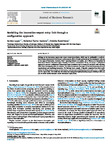Revisiting the innovation–export entry link through a configuration approach
| dc.contributor.author | Lopez, C | |
| dc.contributor.author | Yacine Haddoud, M | |
| dc.contributor.author | Kasturiratne, D | |
| dc.date.accessioned | 2022-07-01T12:48:45Z | |
| dc.date.available | 2022-07-01T12:48:45Z | |
| dc.date.issued | 2022-10 | |
| dc.identifier.issn | 0148-2963 | |
| dc.identifier.issn | 1873-7978 | |
| dc.identifier.uri | http://hdl.handle.net/10026.1/19371 | |
| dc.description.abstract |
Findings on the innovation–export entry nexus remain inconclusive, which may be attributable to methodological issues. Most research has focused on the separate effects of single predictors and has investigated only one or two types of innovation. However, firms’ exporting behavior is complex, and is likely to be determined by interactions between innovation types. Drawing on resource orchestration theory, we adopt a configuration approach to uncover combinations of innovation types (considered here as resources) associated with exporting, rather than investigating them in isolation. The study incorporates four types of innovation: product, process, organizational and marketing innovation. The findings from a sample of Spanish companies show that combinations involving product and process innovation, or product and marketing innovation make a more compelling case for export entry. The results have theoretical and managerial implications that progress thinking in this area and reconcile current literature on the innovation–export nexus. | |
| dc.format.extent | 927-937 | |
| dc.language | en | |
| dc.language.iso | en | |
| dc.publisher | Elsevier | |
| dc.subject | Innovation | |
| dc.subject | Export propensity | |
| dc.subject | Internationalization | |
| dc.subject | Configuration approach | |
| dc.subject | Qualitative comparative analysis (QCA) | |
| dc.title | Revisiting the innovation–export entry link through a configuration approach | |
| dc.type | journal-article | |
| dc.type | Journal Article | |
| plymouth.author-url | https://www.webofscience.com/api/gateway?GWVersion=2&SrcApp=PARTNER_APP&SrcAuth=LinksAMR&KeyUT=WOS:000813036000031&DestLinkType=FullRecord&DestApp=ALL_WOS&UsrCustomerID=11bb513d99f797142bcfeffcc58ea008 | |
| plymouth.volume | 149 | |
| plymouth.publication-status | Published | |
| plymouth.journal | Journal of Business Research | |
| dc.identifier.doi | 10.1016/j.jbusres.2022.05.018 | |
| plymouth.organisational-group | /Plymouth | |
| plymouth.organisational-group | /Plymouth/Faculty of Arts, Humanities and Business | |
| plymouth.organisational-group | /Plymouth/Faculty of Arts, Humanities and Business/Plymouth Business School | |
| plymouth.organisational-group | /Plymouth/Users by role | |
| plymouth.organisational-group | /Plymouth/Users by role/Academics | |
| dcterms.dateAccepted | 2022-05-09 | |
| dc.rights.embargodate | 2022-7-2 | |
| dc.identifier.eissn | 1873-7978 | |
| dc.rights.embargoperiod | Not known | |
| rioxxterms.versionofrecord | 10.1016/j.jbusres.2022.05.018 | |
| rioxxterms.licenseref.uri | http://www.rioxx.net/licenses/all-rights-reserved | |
| rioxxterms.type | Journal Article/Review |


